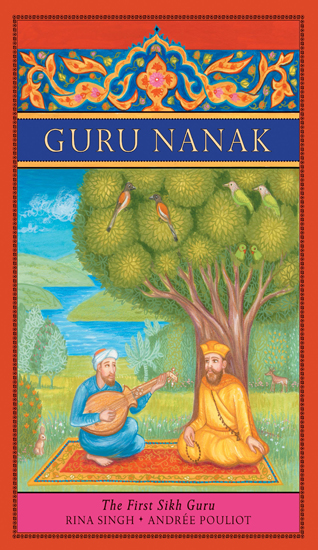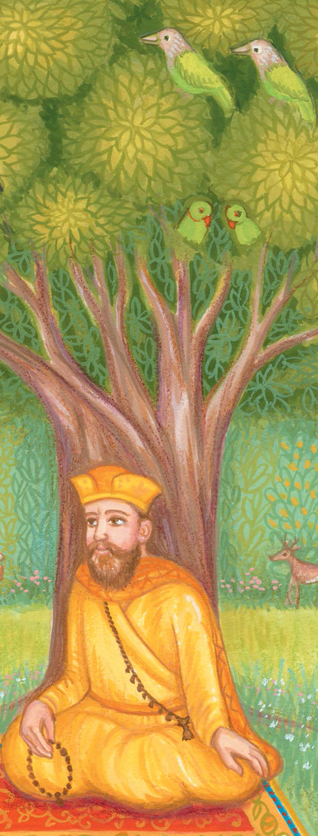Books
Guru Nanak: The First Sikh Guru
A Book Review by GEETANJALI SINGH CHANDA
GURU NANAK: THE FIRST SIKH GURU, by Rina Singh. Illustrated by Andree Pouliot. Groundwood/ House of Anansi, Canada & U.S.A., 2011. Hardcover, Colour, pp 64. ISBN: 978-0-88899-958-0.
We have often been told not to judge a book by its cover. But Rina Singh’s Guru Nanak: The First Sikh Guru tempts you in with it’s alluring cover.
A rich, gold trellis-like emboss frames a miniature style painting. You want to open it and browse. It is a book to savor.
The Introduction does a wonderful job of setting the historic context by giving readers an idea of what life on the subcontinent was like in the 1400’s at the time of the birth of Nanak in 1469.
This is painted in very broad-brush strokes - it is an important historical anchoring that reveals the uniqueness of both Nanak and his teachings. It was a time when Babur, the first Mughal emperor, had invaded the land.
It is also in this period that Christopher Columbus discovered America and Ferdinand Magellan became the first person to voyage around the world.
Nanak was himself an intrepid traveller and many of the stories recount his travels - from the far-flung Himalayas to as far south as Sri Lanka and from Mecca in the West to Assam in the East. At the end, there is a helpful map that shows the itinerary of his travels.
One of the best things about the book is that often the verses from gurbani are integrated with the stories. In the well-loved story of the janeyu (Hindu sacred thread ceremony), for example, when Nanak questions and then refuses the ritual, his powerful verse of exhortation is quoted to make the point:
“Make cotton out of mercy, thread out of contentment;
Knot it with modesty and twist it with truth.
If you have such a thread, then put it on me,
A thread that never breaks or soils,
Never burns or perishes.”
The seamless integration of the gurbani with the story provides a flavor of the magnificent poetry, complex thought and the inherent rebellion against empty rituals, along with the telling of the tale.
Most of the stories are drawn from the Janam Saakhis (literally, birth stories - biographical stories) that were written by faithful disciples or followers.
Although the book has been categorized as “Juvenile literature”, it is elegantly written and equally accessible to both young and older adults. The style is straightforward and neutral. The usual moralistic or didactic elements that characterize these kinds of stories do not burden the text or overwhelm the reader here.
Some of the descriptions, such as of Talwandi – Nanak’s birthplace - are very evocative and you feel as if you know the place.
But brevity is the hallmark of each of the stories. The mood is conveyed with an economy of words that renders them wonderfully readable.
Then there are the eccentric authorial interests that makes them personal too. For example the story about Nanak’s journey to Tibet begins with a description of the shoes that Nanak and Mardana wore and how they “wrapped ropes around the heavy robes to keep warm” - just a practical little detail like that draws attention to just how arduous travel was at the time. It draws
in the reader and involves and connects them to the journey, making it seem more real.
The illustrations by Andree Pouliot in gouache are done in the miniature painting style. They are appealing and yet not overwhelming in detail. The painting style reveals a variety of influences. The waves and clouds especially seem to have a
Tibetan influence.
Some of the figures though strike an odd note. One in particular relates, again, to the depiction of the janeyu ceremony. The figure of Nanak in that is almost a 'Dennis the Menace' kind of cartoon figure. It is certainly not the sage-child one is used to seeing in other depictions of the child Nanak.
Another interesting picture is that of the birth of Nanak where the baby is surrounded by a golden halo of light, which is very reminiscent of Christian holy pictures where baby Jesus was often represented with a halo around his head.
Two of my favorite illustrations accompany the ‘Enlightenment’ story and the other entitled ‘Kartarpur’, which recounts the death of Nanak’s life-long companion, Mardana, the rebec (musical instrument) player. There is an intense luminosity in both these paintings. Both depict river scenes. The contrasts of the colours aquamarine, green and gold are stunning.
The one depicting Mardana’s final hours shows a lotus-filled river where Mardana is laid out on a green patch surrounded by trees and gorgeous white flowers. A variety of birds such as the Hoopoe, kingfishers, ducks and cranes form part of the scene. The picture somehow manages to exude a quiet beauty and yet the sadness is palpable.
Guru Nanak: The First Sikh Guru is a simply and naturally written book. It reads effortlessly and that is probably a sure sign of just how much work went into the writing. The limpid prose tells the story directly. It is also an elegantly produced book that you will treasure. The illustrations are lovely and you will want to browse it often.
CLICK here to view a video introducing the book.
[The reviewer, Dr. Geetanjali Singh Chanda, is Senior Lecturer in the Women’s, Gender & Sexuality Studies Program at Yale University. Her earlier work, “Sikh Masculinity, Religion and Diaspora in Shauna Singh Baldwin’s 'The English Lesson and Other Stories' ", was published in the journal, “Men and Masculinities”, in February 2009. She is the author of "Indian Women in the House of Fiction", published By Zubaan.]
March 10, 2012
Conversation about this article
1: Baldev Singh (Bradford, United Kingdom), March 10, 2012, 1:10 PM.
A welcome addition to the body of literature on The House of Nanak!




